Tuna At the Rail
A headboat ride to the canyons is a fun and accessible way to experience offshore fishing.

Nothing shrinks a 100-foot aluminum head boat like running 150 miles from port to the Northeast Canyons. You claimed your spot on the deck, tucked your gear away, and crawled into a bunk some 6 hours ago in the pitch black as the boat pointed south so you could be well rested for the marathon of fishing that lay ahead. The engines that hummed you to sleep on the way out change their tune from a determined chug to a muted gurgle. You excitedly pop up from your bunk and ready yourself to fish for some tuna. As you walk out on deck, you realize the massive Helen H that towered above you at the dock in Hyannis, Massachusetts, is now just a tiny speck in a vast ocean.
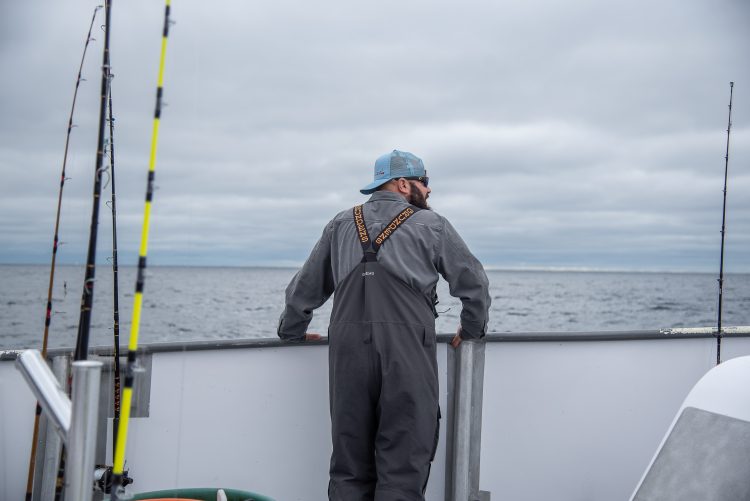
It’s humbling to feel so small on such a big boat when there’s nothing but an open ocean in every direction. Even so, as small as you may feel at that very moment, the reason you’re there sinks in, bringing with it enormous excitement for what could be in store for the day and a half to come.
If it’s your first time at the Canyons, you can’t begin to dream up what might happen. However, even if you have been before, you’re still in store for something you’ve never witnessed before. That’s the beauty of a Canyon trip.
Uber To the Canyons
The most cost-effective way to experience a Canyon trip is to grab a shared ride to the promised lands. For $500 to $600, a spot on a party boat headed to the edge is a heck of a lot cheaper than owning a canyon-capable boat or shelling out thousands for a private charter.
I booked a trip on the Helen H with my co-worker Jimmy Fee for early October—prime time for Canyon headboat fishing—to film an episode of On The Water’s party-boat fishing series, At The Rail, to get a taste of Northeast-style long-range fishing. We were scheduled to leave at 5 a.m. on a Thursday and return Friday evening. As the date approached and it was clear we’d be sailing, we began prepping to ensure we made the most of Ubering to the Canyons.
Dress For Success
Fishing on a boat for two days while so far from shore is going to throw some curveballs. The high temps and blazing sun midday may turn to frigid cold overnight. The chance to get wet, whether it’s from rain, waves, or even the errant spray of a hose is ever-present. Your main goal is to stay dry and warm. If you get wet, your ability to stick it out at the rail the entire trip is in serious jeopardy. You can always shed layers, so wear them wisely with the goal to be warm and dry no matter what happens.
Layering Up For A Headboat Overnighter To The Canyons

Outer Layer: Grundens Buoy X Bibs and Jacket
Lighter-weight bibs like the Gore-Tex Grundens Buoy X are more comfortable in warmer temperatures and allow plenty of room for layering underneath when it gets cold. The outer shell protects from wind and rain (and chum, fish blood, and spilled energy drinks), and adds a final layer against the cold.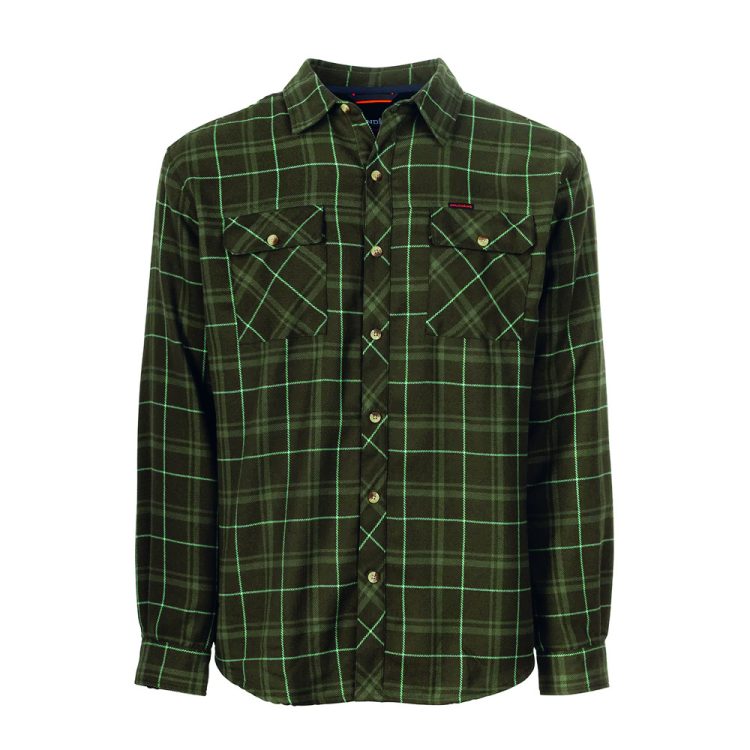
Mid-Layer: Grundens Kodiak Insulated Flannel Shirt
A flannel shirt or thick hooded sweatshirt is great for keeping the cold at bay while fishing through the night, and can be easily removed when the sun, or a wide-open tuna bite, turns up the heat.
Base Layer: Grundens Thermal Bottom
When I’m on an overnight headboat tuna-fishing trip, I live in my bibs, so I wear a base layer that’s warm, comfortable, and won’t bunch up. This means leaving the jeans at home in favor of thermal pants.
Footwear: Grundens Deck Boss Boot
Ankle deck boots are great for summertime fishing, but on a headboat, I want a full-length boot to provide traction on slippery decks and splash protection from hoses, chum buckets, and thrashing tuna.
Gear Up (or Don’t)
On many Canyon party-boat trips, you can walk on board without a single rod and still have a successful trip by renting tackle. If you’re going to do so, I strongly recommend talking to the operator beforehand to ensure you ’re covered with capable gear. The Helen H has plenty of premium conventional tackle spooled for presenting the herring, sardines, and whole squid they provide for tuna fishing.
If you do decide to rent your main tuna rod, also bring a light spinning rod and squid jigs with braided line and 12- to 15-pound-test fluorocarbon leader, as well as a slightly heavier inshore spinning rod for mahi-mahi. I chose to bring my own gear. With four rods and reels, I felt prepared for whatever the Canyons might throw at me.

Captain Joe’s Tips for Offshore Overnighters
On this trip, we headed all the way to Hudson Canyon, some 150 miles from port, since that was where the best water had settled after some fall storms. On the long ride out, we sought the advice of Captain Joe for making the most of our trip. He offered the following:
1. Sleep when the boat is running.
Getting as much shuteye as possible on the ride out gives you the best chance of fishing the entire time since you never know when the bite will turn on. It could be just as fishing starts or not until 3 a.m., so if you run out of steam, you may miss the one or two flurries if it’s not an action-packed trip from start to finish.
2. Pay attention to what the captain and mates say and what other anglers are doing.
On these trips, there is usually a mix of beginners and regulars. The captain and mates are regularly out on the water and they’re the ones monitoring the electronics in the wheelhouse, so be ready when they say they’re marking fish at a certain depth. Take note of how other anglers are hooking their baits, the speed at which they pay out line, and whether they’re hooking up by jigging, then adjust accordingly.
I had planned to be as versatile as possible so I covered my jigging bases with butterfly jigs, slow-pitch jigs, and soft-plastic RonZs. If we got into fish while trolling, I was ready to run to the bow and drop a jig as soon as the boat slowed.
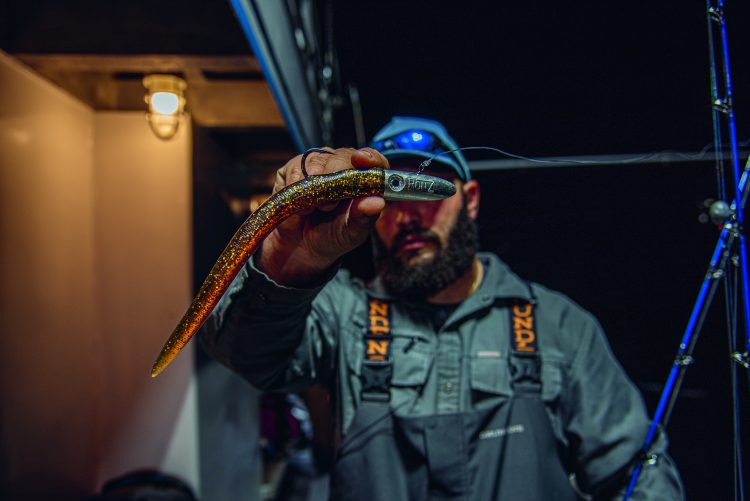
While some headboats get right to chunking on their offshore trips, the Helen H mixed in some trolling. To give every angler a shot at catching on the troll, the mates set out 10 to 12 rods and assigned one to each angler. Since there were more anglers than rods, we worked in shifts, 20 minutes on, 20 minutes off, each hoping our rod would get the bite while we were up.
For jigging, I paired a Tsunami Carbon Shield II with a Shimano Twin Power 14000 spinning reel spooled with 65-pound-test braid and 80-pound-test Seaguar Gold Label fluorocarbon leader. I also had a bait rod for when the boat settled in on the chunk bite at night. This combo was a Tsunami Carbon Shield II conventional rod paired with Maxel Ocean Max 10 spooled with 80-pound-test Seaguar Threadlock braid, a 100- to 150-foot section of 80-pound-test mono to add some stretch, and then a swivel connected to a 10-foot section of 80-pound Seaguar Blue Label. Above the swivel, I placed an egg sinker (with a bead behind it to protect the knot) to help get my bait in front of the tuna. However, Matt Sellito, head mate on the Helen H, recommended swapping egg sinkers for fish-finder slides and bank sinkers, which meant faster weight adjustments in the heat of the moment.

With my jigging and chunking setups covered, the other two were a small spinning setup for jigging squid and a 50-wide to deploy a rigged squid for swordfish in the wee hours of the morning when I hoped the number of fishermen grinding it out would dwindle, allowing a little extra room to swing for the fences.
Be Ready for Anything
As soon as we got to the fishing grounds, the mates set the spread and we began trolling for a couple of hours. There wasn’t much action, so Capt. Joe returned to where he’d seen the most activity on the sounder and the mates began chumming and chunking. The idea was to build a steady stream of chum to ring the dinner bell for the tuna we marked deep.

Not long after we started chumming, I spotted a mahi and grabbed a small piece of bait out of the chum bucket, reeled up my whole squid meant for tuna, and slowly let a bite-sized piece of chum down, which was quickly gobbled up. As other anglers saw this, they also started focusing on mahi, and before you knew it, everyone was swinging mahi over the side of the boat.
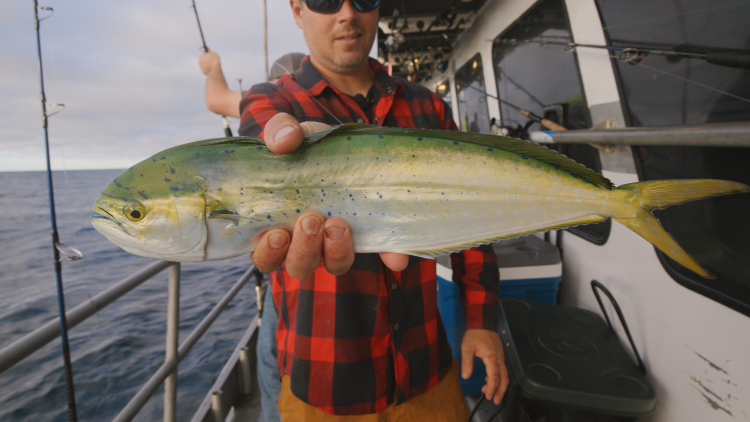
We drifted by a few high-flyers, which just intensified the drop-and-reel mahi action. Once Jimmy and I caught our fill of mahi, I started wondering what bigger predators might be beneath the feeding frenzy and started dropping jigs, hoping for the first tuna or perhaps even a wahoo. With no luck other than more mahi, daylight started to fade and our anticipation for tuna grew stronger.
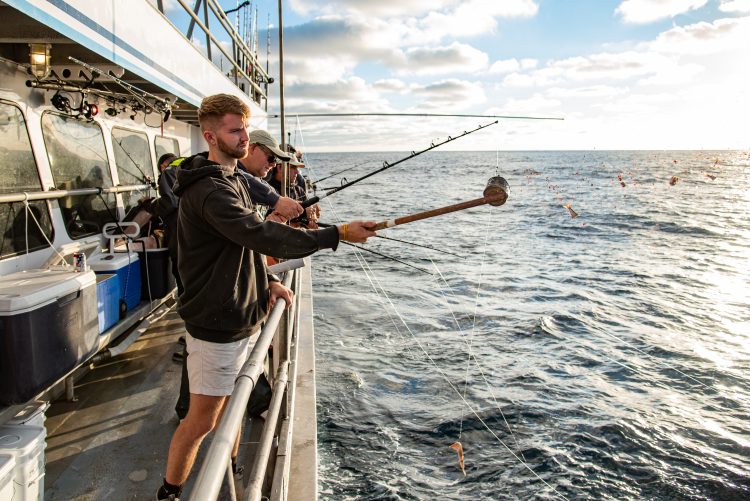
As darkness wiped away the gorgeous sunset, all of us stayed at the rail, meticulously lowering our sardines or whole squid into the depths by pulling out 3 feet of line at a time. The goal was to slowly have the bait descend at the same speed as the chum sank. We readied ourselves for what could be a long night of waiting since one of the mates said it could happen at any time. He mentioned that the tuna bite hadn’t gone off until around 3 a.m. on the last few trips, though it had lasted well into the morning.
I figured this would be a good time to head up to the top deck and floss some loops on my 50-wide to attach a strobe light/weight combo to the bottom one about 50’ from my hook and another one 100 feet above it, where my homemade sword float would get clipped on via a longline clip. Jimmy had made sword floats from his kid’s pool noodle, a tip we picked up while swordfishing with accomplished offshore fisherman Larry Backman. Just as I started flossing the second loop, I looked down to see what I thought was a fat butterball of a yellowfin free-swimming up in the boat’s lights. I yelled, “Tuna! Someone get a hook in that thing!” and dropped what I was doing to run down and try to do just that.

However, I quickly saw that the fish had been hooked by someone up on the bow. I grabbed my chunking rod, hooked a whole squid, and started paying out line a few feet at a time, trying to quell my excitement. Another angler hooked up, then another, so Jimmy and I were getting anxious. When the bites start coming fast and furious, I want to capitalize so badly that I start thinking about what I could do differently. Just as I was questioning everything I was doing, with the mono in my hand and my rod secured in the rod holder, clicker on, I felt a thump. I told Jimmy I had a bite just as the line pulled right out of my hand.
I picked up my rod, engaged the drag, flipped off the clicker, and started cranking. Now came the fun part—trying to navigate around 30 other anglers, some hooked up, some trying to hook up, with a rambunctious tuna on the end of the line, fighting for its life. This sounds impossible, but with a crew as experienced as the one on the Helen H, I was quickly coached, as were the rest of the anglers in my way, on how to weave my fish through a maze of lines cascading down the water column beneath the boat.
After about 15 minutes, I saw a big, fat yellowfin circling below while Capt. Joe and a mate stood nearby, ready with gaffs. They sank one into my first party-boat yellowfin and heaved it over the rail before swiftly moving on to other anglers about to get their fish in gaff range.
My fish got a tuna spike right through its brain, instantly dispatching it, then a numbered tag was zip-tied to its tail to identify whose it was. A mate took it to the back of the boat to an ice slurry where it would remain until the boat returned to port and the fish were processed.
Over the course of this flurry, about a dozen yellowfin tuna were landed—not a bad percentage at all with 30 lines fishing. Once I returned to fishing, Jimmy got a bite but broke off. Rather than re-rig, he dropped a RonZ to minimize his time out of the water. He got a hit on it, but the fish missed the hook and all went quiet. One angler battled and released a nice swordfish, and most of the anglers got a chance to fight a tuna. I headed back up top to finish rigging for swords, even more excited since I’d confirmed they were around.
It wasn’t long afterward when someone hooked another tuna, so I ran down again, grabbed a jigging rod and started fishing. Jimmy had just caught a couple squid, but they were on the smaller side, so I put one on my rod. Not long after it swam out of sight, I was tight again to something pulling a lot harder and faster. It took a blistering run and just as I was turning it, I broke it off. Lesson learned: re-rig my leader after landing a fish. Things had started to slow again, and just as I got back up top to finally finish rigging my sword rod, Jimmy hooked a fish on the RonZ.
I watched him travel around the entire transom twice, fighting his fish aggressively but patiently, holding my breath each time he cleared a transom corner. It was a quality yellow on the lightest jigging rod we’d brought for tuna. Jimmy finally got it to the gaff, and over the rail came our second fat yellowfin. This fish turned out to be one of the last tunas hooked that night, so more and more anglers left the deck to grab naps.
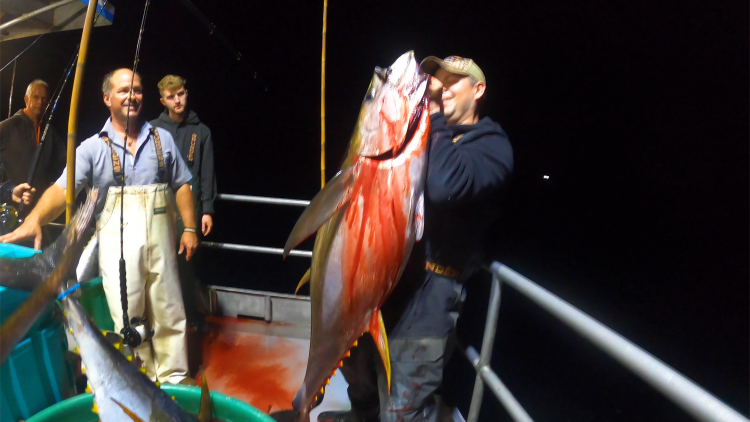
Jimmy and I took the extra room to deploy two rods meant for swordfish. I rigged up squid, flossing them in on the hooks for so they’d sit naturally 200 feet below the floats. I hoped the added durability would hold up to swords thrashing them before eating.
Almost as soon as Jimmy’s bait settled, he was bit; not long after that, a big blue shark was boatside. At the same time, my float laid down and then took off. I knew this was different than the bite Jimmy had just gotten because it was more “athletic,” though I had other issues. In my trips up top to floss my loops on my sword rod, the only floss I could find seemed a little thick for the job.
As I was getting the fish closer, we managed to get the float off and that first loop barely passed through the guide. I recruited a mate to help pull the second loop through when the time came because I knew that one was worse. With Jimmy still dealing with his blue shark, one of the mates and I got the strobe light/weight off and then Wicked Tuna style, pulled it through the top guide just to realize it was totally stuck. Matt, the head mate, came over and asked how far the stuck loop was from the hook, to which I replied, “Fifty feet.”
He laughed and started hand-lining. Just then, the few guys still fishing on the transom corner hollered, “Who’s got a pup-swordfish?” What would have been my first-ever swordfish proceeded to swim under the running gear, cut me off, and went on his merry way with a little memento from our encounter in the form of a new lip piercing.

As we neared dawn, we switched back to focusing on tuna. That first-light bite came and went with a whimper, with only a few fish hooked and one more landed. We fished until mid-morning and started trolling in the direction of home before picking up all lines and heading back to port.
This trip was a perfect example of the need to be ready to capitalize on any and all opportunities. We hadn’t expected the tuna action to heat up until the early morning, but the best fishing was actually between 9 p.m. and midnight. We took a swing at swords, and everybody aboard caught enough mahi to keep them in fish tacos well into winter. And, like any Canyon trip, there were unforgettable sights beyond the target species including whales, porpoises, manta rays, and a whale shark. We slept well on the ride home, our coolers full, our arms tired, dreaming of another party-boat canyon trip next fall.
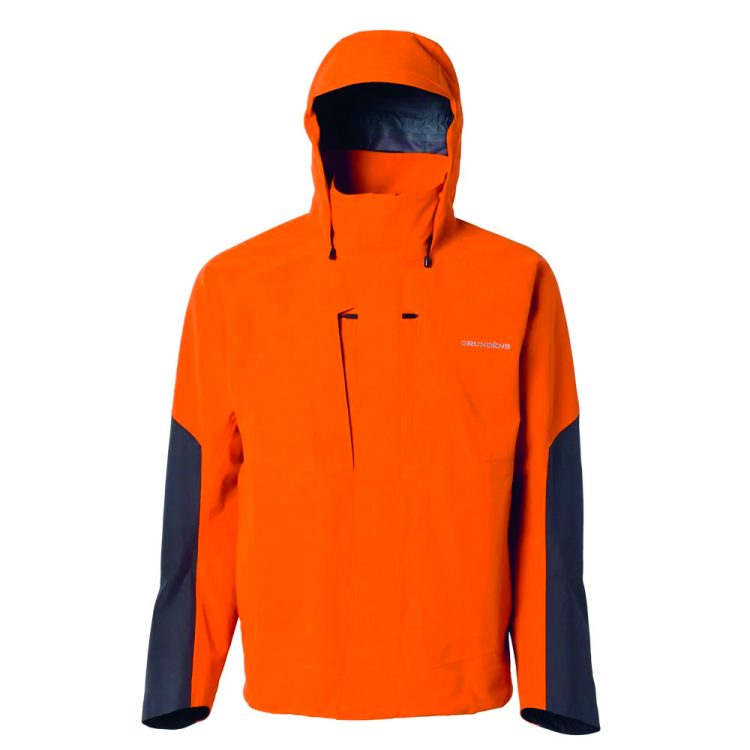
Leave a Reply